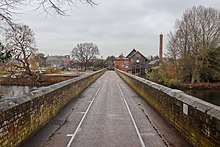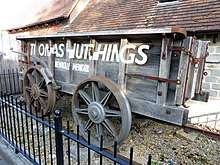Stratford and Moreton Tramway
The Stratford and Moreton Tramway was a 16-mile (25-km) long horse-drawn wagonway from the canal basin at Stratford-upon-Avon in Warwickshire to Moreton-in-Marsh in Gloucestershire, with a branch to Shipston-on-Stour.


History
The tramway was intended to carry Black Country coal to the rural districts of southern Warwickshire via the Stratford-on-Avon Canal, and limestone and agricultural produce northwards. The parliamentary act for the line was passed in 1821 and construction was completed in 1826, the route having been surveyed by the railway promoter William James and engineered by John Urpeth Rastrick. The branch to Shipston was built in 1836.
The line functioned as a horse-drawn tramway for several decades, but did not prosper. In 1851 the Oxford, Worcester & Wolverhampton Railway was opened through Moreton-in-Marsh and the tramway began experimenting with steam operation, adopting Stephenson's 4'-8½" gauge.[1]
In 1859 the southern section between Moreton and Shipston was converted into a steam-hauled railway. The tramway company went bankrupt in 1868, and the line was taken over by the Great Western Railway.
The northern section of the line from Shipston to Stratford continued to be used as a horse-drawn branch-line carrying lime until the 1880s, when it fell into disuse. The tracks were lifted in 1918 as part of the war effort, and the line was formally abandoned in 1926, exactly 100 years after it had been opened. On the southern section between Moreton and Shipston a steam-hauled passenger service operated until 1929, when buses took over. The line was used by occasional freight trains until 1960, when it was closed and dismantled.
Remains
The tramway's bridge across the River Avon at Stratford remains in use by pedestrians, and is known as the Tramway Bridge.
One of the horse-drawn wagons, which belonged to Thomas Hutchings of Newbold Lime Works, is preserved near the Shakespeare Memorial Theatre in Stratford-on-Avon.[2] Newbold Lime Works would probably have been at Newbold on Stour, rather than Newbold-on-Avon.
References
Notes
- "GWR Route: Moreton-in-Marsh to Stratford upon Avon Tramway". www.warwickshirerailways.com.
- "Industrial Rail Record No.11". Industrial Railway Society. September 1966. p. 276.
Sources
- Macnair, Miles (2007). William James (1771-1837): the man who discovered George Stephenson. Oxford: Railway and Canal Historical Society. ISBN 978-0-901461-54-4.
- Norris, John (1968). "The Stratford and Moreton Tramway". In Hadfield, Charles (ed.). Waterways to Stratford. Newton Abbot: David & Charles. pp. 125–59. ISBN 0-7153-4231-2.
- Slater, Terry (1981). A History of Warwickshire. London: Phillimore. ISBN 0-85033-416-0.
- White, H.P. (1986). Forgotten Railways. Newton Abbot: David St John Thomas. ISBN 0-946537-13-5.
- Jenkins, S.C.; Carpenter, R.S. (1997). The Shipston-on-Stour Branch. Didcot: Wild Swan. ISBN 1-874103-34-8.
External links
| Wikimedia Commons has media related to Stratford and Moreton Tramway. |